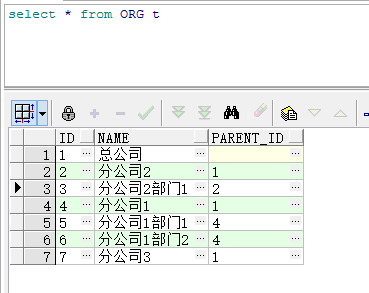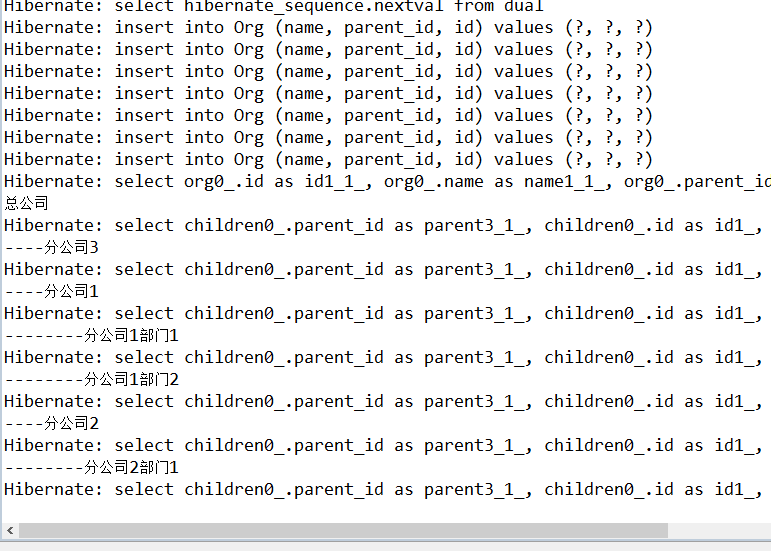Tree是一种比较常见的数据展示类型,本文简单探讨一下hibernate实现创建Tree的过程。
首先简介一下Tree,每一个节点需要有一个对父节点id的引用,即Tree实体类中需要有对父节点的引用,使用Many2One,当然,关联是双向的,同时,还要有对子节点的引用,使用One2Many,因为关联是双向的,所以会使用到mappedBy
1.本例使用树实体类使用Org,除声明id和name属性外,还需要引用父节点Org parent,并在getParent上使用ManyToOne
同时需要引用子节点的集合Set<Org> children,并在getChildren上使用@OneToMany(mappedBy="parent")
Org
package com.baosight.model;
import java.util.*;
import javax.persistence.CascadeType;
import javax.persistence.Entity;
import javax.persistence.FetchType;
import javax.persistence.GeneratedValue;
import javax.persistence.Id;
import javax.persistence.JoinColumn;
import javax.persistence.ManyToOne;
import javax.persistence.OneToMany;
@Entity
public class Org {
private String id;
private String name;
private Set<Org> children = new HashSet<Org>();
private Org parent;
@Id
@GeneratedValue//auto
public String getId() {
return id;
}
public void setId(String id) {
this.id = id;
}
public String getName() {
return name;
}
public void setName(String name) {
this.name = name;
}
@OneToMany(mappedBy="parent",cascade=CascadeType.ALL,fetch=FetchType.EAGER)
public Set<Org> getChildren() {
return children;
}
public void setChildren(Set<Org> children) {
this.children = children;
}
@ManyToOne
@JoinColumn(name="parent_id")
public Org getParent() {
return parent;
}
public void setParent(Org parent) {
this.parent = parent;
}
}
hibernate的配置文件hibernate.cfg.xml
<?xml version='1.0' encoding='utf-8'?>
<!DOCTYPE hibernate-configuration PUBLIC
"-//Hibernate/Hibernate Configuration DTD 3.0//EN"
"http://hibernate.sourceforge.net/hibernate-configuration-3.0.dtd">
<hibernate-configuration>
<session-factory>
<!-- Database connection settings -->
<property name="connection.driver_class">oracle.jdbc.driver.OracleDriver</property>
<property name="connection.url">jdbc:oracle:thin:@127.0.0.1:1521:orcl</property>
<property name="connection.username">scott</property>
<property name="connection.password">tiger</property>
<!-- JDBC connection pool (use the built-in) -->
<!-- <property name="connection.pool_size">1</property> -->
<!-- SQL dialect -->
<property name="dialect">org.hibernate.dialect.Oracle9iDialect</property>
<!-- Enable Hibernate's automatic session context management -->
<property name="current_session_context_class">thread</property>
<!-- Disable the second-level cache -->
<property name="cache.provider_class">org.hibernate.cache.NoCacheProvider</property>
<!-- Echo all executed SQL to stdout -->
<property name="show_sql">true</property>
<!-- <property name="format_sql">true</property> -->
<!-- Drop and re-create the database schema on startup -->
<!-- <property name="hbm2ddl.auto">update</property> -->
<mapping class="com.baosight.model.Org"/>
</session-factory>
</hibernate-configuration>JUnit测试类
package com.baosight.model;
import org.hibernate.Session;
import org.hibernate.SessionFactory;
import org.hibernate.cfg.AnnotationConfiguration;
import org.hibernate.cfg.Configuration;
import org.hibernate.tool.hbm2ddl.SchemaExport;
import org.junit.AfterClass;
import org.junit.BeforeClass;
import org.junit.Test;
public class OrMappingTest {
private static SessionFactory sf = null;
@BeforeClass
public static void beforeClass(){
new SchemaExport(new AnnotationConfiguration().configure()).create(false, true);
// 读取配置文件
Configuration cfg = new AnnotationConfiguration();
// 得到session工厂
sf = cfg.configure().buildSessionFactory();
}
@Test
public void testSave() {
Org o = new Org();
o.setName("总公司");
Org o1 = new Org();
o1.setName("分公司1");
Org o2 = new Org();
o2.setName("分公司2");
Org o3 = new Org();
o3.setName("分公司3");
Org o11 = new Org();
o11.setName("分公司1部门1");
Org o12 = new Org();
o12.setName("分公司1部门2");
Org o21 = new Org();
o21.setName("分公司2部门1");
o.getChildren().add(o1);
o.getChildren().add(o2);
o.getChildren().add(o3);
o1.getChildren().add(o11);
o1.getChildren().add(o12);
o2.getChildren().add(o21);
o1.setParent(o);
o2.setParent(o);
o3.setParent(o);
o11.setParent(o1);
o12.setParent(o1);
o21.setParent(o2);
Session session = sf.getCurrentSession();
session.beginTransaction();
session.save(o);
session.getTransaction().commit();
}
@Test
public void testLoad() {
testSave();
Session s = sf.getCurrentSession();
s.beginTransaction();
Org o = (Org) s.load(Org.class, "1");
//输出Tree
print(o,0);
s.getTransaction().commit();
}
private void print(Org o, int level) {
// TODO Auto-generated method stub
String preStr = "";
for(int i=0;i<level;i++){
preStr +="----";
}
System.out.println(preStr+o.getName());
for(Org org:o.getChildren()){
print(org,level+1);
}
}
/*@Test
public void testSchemaExport() {
}*/
@AfterClass
public static void afterClass(){
// 关闭session工厂
sf.close();
}
}
测试结果
3.使用testLoad打印Tree
3.1不使用fetch时的结果
3.2在@OneToMany使用fetch=FetchType.EAGER时的结果为
以上即为hibernate对于Tree的简单实现,在具体使用到Tree时,还需要做相关的调整,需要仔细体会。




























 88
88

 被折叠的 条评论
为什么被折叠?
被折叠的 条评论
为什么被折叠?








